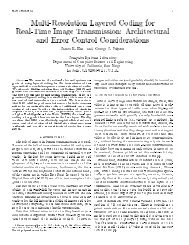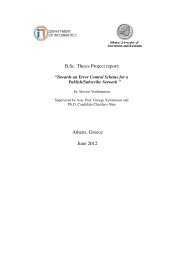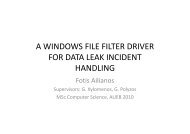In Network Processing and Data Aggregation in
In Network Processing and Data Aggregation in
In Network Processing and Data Aggregation in
Create successful ePaper yourself
Turn your PDF publications into a flip-book with our unique Google optimized e-Paper software.
Exemplary aggregates, on the other h<strong>and</strong>, may be highly <strong>in</strong>accurate ifeven a few messages are lost. Such aggregates <strong>in</strong>clude MIN, MAX, <strong>and</strong>MEDIAN.3. Monotonic aggregates.Aggregates that allow early test<strong>in</strong>g of predicates <strong>in</strong> the network aremonotonic. For example, assume the user requests the MAXtemperature read<strong>in</strong>g <strong>in</strong> the network. As source nodes report theirvalues toward the host node, other nodes may listen <strong>and</strong> only reporttheir own values if they are greater than the current MAX. Thisprovides sav<strong>in</strong>gs <strong>in</strong> the overall number of messages sent through thenetwork without affect<strong>in</strong>g the result.4. Partial state requirements.The amount of partial state <strong>in</strong>formation required differs amongaggregate functions. Aggregates such as SUM <strong>and</strong> COUNT requirepartial state records that are the same size as the f<strong>in</strong>al aggregate. TheAVERAGE function requires a partial state record conta<strong>in</strong><strong>in</strong>g two values(both the SUM <strong>and</strong> COUNT). Other aggregates such as MEDIAN <strong>and</strong>HISTOGRAM require that the entire dataset be returned to the hostnode unless some type of compression or estimation is used (see [10]).3.4 A Taxonomy of Current <strong>Aggregation</strong> Approaches3.4.1 Tree-Based TechniquesLow level Nam<strong>in</strong>g – Filter Based [4]<strong>In</strong> order to illustrate the way <strong>in</strong> which <strong>in</strong>-network process<strong>in</strong>g can reduce data traffic toconserve energy, an example of filter-driven data aggregation us<strong>in</strong>g Directed Diffusion ispresented below. The scope of an anticipated sensor application is to query a number ofsensors so as to be able to take some action when one or more of the sensors is activated.Take as an example a surveillance system which could notify a biologist if an animalenters a specific region. <strong>In</strong> order to ensure robust coverage, the coverage of deployedsensors will overlap <strong>and</strong> as a result, one event is likely to trigger multiple sensors of thenetwork. Every sensor will report detection to the user whereas communication <strong>and</strong>








